Taking advantage of the brilliant weather, we headed out for an overnight excursion. Our destination: Metéora, the largest complex of Orthodox monasteries in Greece, outside of Mount Athos.
The monasteries are built atop almost inaccessible sandstone peaks, at the northwestern edge of the Plain of Thessaly near the Pineios River and Pindos Mountain, in central Greece.
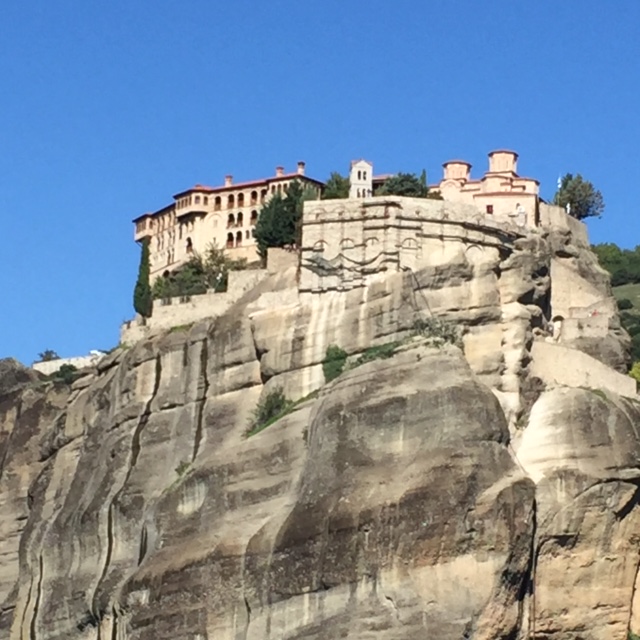
Monks settled on these ‘columns of the sky‘ from the 11th century onwards. Twenty-four monasteries were built, despite incredible difficulties, at the time of the great revival of the eremitic ideal in the 15th century. Today there are six left.
To break up the four-hour journey, we stopped for a snack in the town of Domokos. The crisis is apparent here as well, with a lot of empty shops in the central street. An abrasive woman in a red pickup honked as we tried to park the car. The taverna that had been recommended to us was shut. We asked the woman, who was by now walking down the street, where we could get something to eat, and in two minutes she had managed to sell us a bag of beans – her own production – which she offered to bring to the kebab shop, apparently our best bet.
 As we walked down the street, ultra-modern shops alternated with more decrepit ones like the one in the picture above, which took us straight back to the 60s. Pyjama bottoms, socks, plastic baskets and kitchen paper – and those rolls of PVC tablecloth in hideous prints that most Greeks used in their kitchen! Some still do, apparently.
As we walked down the street, ultra-modern shops alternated with more decrepit ones like the one in the picture above, which took us straight back to the 60s. Pyjama bottoms, socks, plastic baskets and kitchen paper – and those rolls of PVC tablecloth in hideous prints that most Greeks used in their kitchen! Some still do, apparently.
Walking into the kebab shop, we looked at each other in dismay. It was tiny, grotty, and the clients consisted of two crusty old men and an elderly lady, sitting at small metal tables. A half-eaten, uninspiring gyros was roasting on a spit. Amazingly, the young man behind the counter made us delicious grilled cheese and tomato sandwiches that were just perfect. In the time it took to fire up the grill, we had become firm friends with everyone. The old guys chattered away through their dentures, the lady spoke Greek with a very strong local accent but perfect English to someone on the phone, and the abrasive woman came in for a bite with us (she had the gyros), bringing the aforementioned bag of dried white beans. We answered the usual ‘Where are you from?’ questions, discussed the monasteries’ hospitality policy, and found out the best place to buy local cheese.
On to Metéora, which was simply magical. There is no other word to describe it.
Metéora in Greek means ‘suspended in the air.’ The sheer majesty of the rocks upon which the monasteries are perched like eagle nests is breathtaking. The monasteries themselves are large, complex, beautiful structures that look as if they’ve emerged from the rock.
We started with the biggest one, Great Metéoro. Nowadays there is a road leading up to the opposite mountain slope. We scrambled down one flight of steps, crossed a bridge spanning the chasm, passed through a tunnel hewn in stone and, finally, faced a climb up another large number of steps – 330 to be precise – to emerge at last upon a stunning view.
The monastery church is a perfect specimen of Byzantine architecture; the 16th-century frescoes covering the walls mark a key stage in the development of post-Byzantine painting. The large courtyard is planted with cypress trees.
Before leaving we inspected the crude net and primitive pulley system by which monks were lowered, at great danger, to the ground, in the days before the road was built.
After climbing back down all those steps it was time to repair to our hotel, the Dellas Boutique Hotel, a stone building just outside Kalambaka, which is the nearest town. The welcome was warm, and the lounge contained a bar, comfortable chairs and even board games. The smiling girl in charge gave us maps of the area and recommended we visit an exquisite Byzantine church in the town. Then she sent us off to dinner at a taverna down the road serving local specialties.
Our rooms had a great view on the rocks, which were floodlit at night, the fissures and crannies casting mysterious shadows. At breakfast there were home-made jams and cake, local yogurt and honey scented with pine, oregano and thyme. When I asked where I could buy some to take home, I was directed to the local butcher’s! As well as a large display of appetizing meats, he sold all sorts of other products: fresh eggs, herbs, the said honey, even slabs of salted cod. I got my honey, plus some local cheeses; after which he gave me a present of his homemade country sausages, which he even vacuum-packed for me!
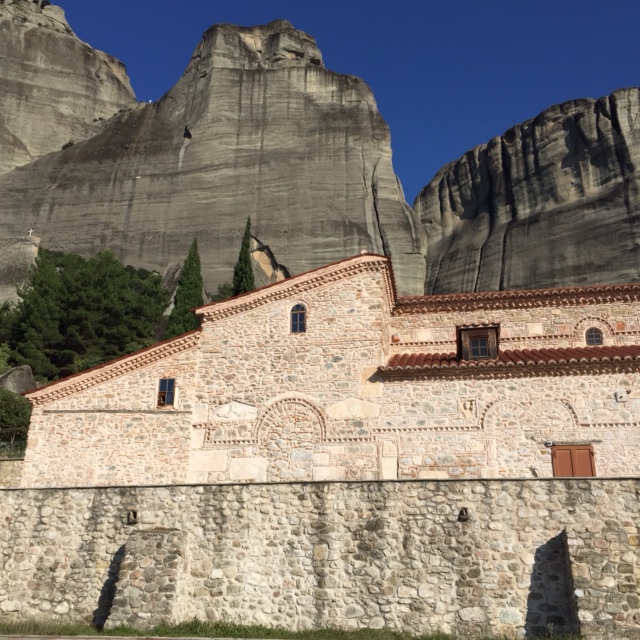 The 11th-century Byzantine Church dedicated to the Virgin Mary – in Kalambaka itself – which was our first stop, exceeded expectations. With beautiful and intricate rose-colored brickwork on the outside, its inside walls were covered with frescoes of the Saints and the pillars were of solid marble, since the church was built on top of a temple to Apollo. Part of the floor has been dug up to expose the ancient mosaics.
The 11th-century Byzantine Church dedicated to the Virgin Mary – in Kalambaka itself – which was our first stop, exceeded expectations. With beautiful and intricate rose-colored brickwork on the outside, its inside walls were covered with frescoes of the Saints and the pillars were of solid marble, since the church was built on top of a temple to Apollo. Part of the floor has been dug up to expose the ancient mosaics.
 Next we made our way to the monastery of Saint Nicholas Anapafsas. We parked the car on the edge of a wood, and there was the monastery, about two miles up in the sky above us! It looked unreachable. As we climbed rough-hewn steps through the woods, the undergrowth was strewn with pink cyclamen and the air was crystal clear. In no time we were at the foot of the walls, and then up the 270 steps to the top. One sole monk lives in this monastery, but it was bustling with life. A lady sweeping the floor told us she worked there ‘for the views’, a bunch of workmen were putting new tiles on the roof, a Japanese tourist was availing himself of the bread and loukoumi (Turkish delights) set out for visitors. The monk said to us, ‘Up here you are in heaven.’
Next we made our way to the monastery of Saint Nicholas Anapafsas. We parked the car on the edge of a wood, and there was the monastery, about two miles up in the sky above us! It looked unreachable. As we climbed rough-hewn steps through the woods, the undergrowth was strewn with pink cyclamen and the air was crystal clear. In no time we were at the foot of the walls, and then up the 270 steps to the top. One sole monk lives in this monastery, but it was bustling with life. A lady sweeping the floor told us she worked there ‘for the views’, a bunch of workmen were putting new tiles on the roof, a Japanese tourist was availing himself of the bread and loukoumi (Turkish delights) set out for visitors. The monk said to us, ‘Up here you are in heaven.’
The next two monasteries we visited were nunneries, and the female touch was evident. They both had lovingly-tended gardens, full of roses and lavender. The larger of the two, Aghios Stephanos, is inhabited by 31 nuns.
The monasteries have small museums containing frescoes, precious relics and illuminated manuscripts. Every window or terrace has a different view, of the rocks, of the other monasteries seen from below or from above, of the Thessaly plain and the glint of the river.
The people who first climbed the rocks and built upon them, trying to find protection from the raids of various conquerors, established a tradition of Orthodoxy which has continued uninterrupted for 600 years. Today the Metéora is included on the UNESCO World Heritage List.
Before heading for home, we made a detour to catch a glimpse of the man-made Plastiras Lake, named after the Greek prime minister who had the vision of building a dam across the Tavropos River in order to irrigate the plain of Thessaly. It was a glimpse only, since the lake is large and surrounded by an area of exceptional natural beauty. It merits a trip in itself, in order to explore the villages surrounding it and enjoy the various activities on offer. We only had time to stop for a delicious lunch at a roadside taverna, where once again the owners were friendly and welcoming, as well as being great cooks! After lunch and a chat, we walked through oak woods dotted with mushrooms to the shores of the lake, whose waters were calm and clear as well as – we were told – teeming with fish.
Some photos are mine , others by Anna Koenig. I will leave you to guess which! To go on the Dellas Hotel site, click on the name. Great value for money.



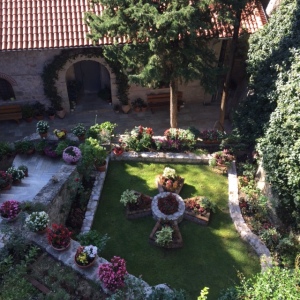
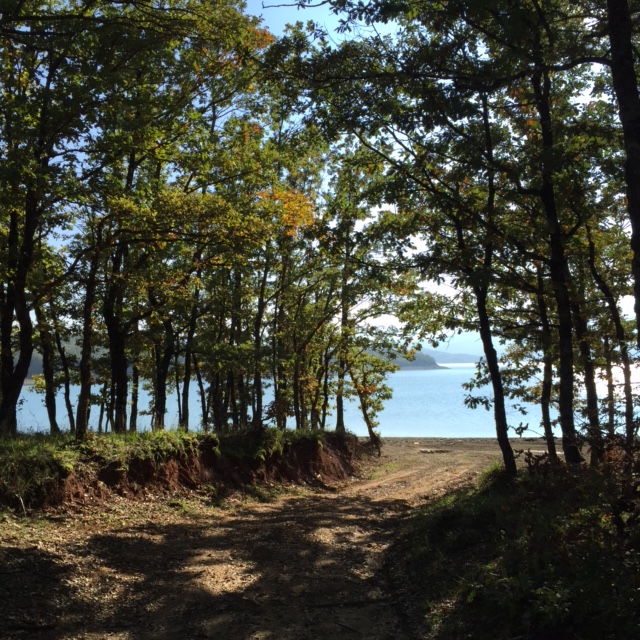
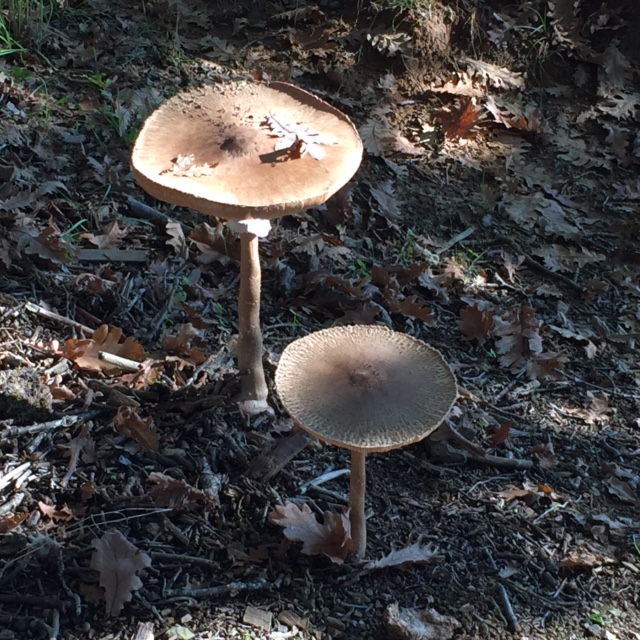

Thanks for reminding me of such an atmospheric place. As a complex of buildings they are truly unique. An unsung wonder of the world. I visited the monastery about 25 years ago. I also recall the hospitality of the monks who were not in the least bothered by tourism. I recall one monk allowing us to sample their own ‘home made’ raki. The views from the top are incredible. How they managed to build it in the first place in such a precarious position is beyond me. Great pictures. especially the monastery in the mist. When I went it was a very hot day in August so no mist.
LikeLike
This is incredibly beautiful, thank you for sharing 🙂
LikeLike
These places look beautiful. Thank you for posting themâ¦â¦F
LikeLike
Your pictures are fabulous, the one of the monasteries shrouded by mist incredible. What a fascinating place to be able to visit.
LikeLike
Lovely post you made me want to pack my bag’s right now and visit, certainly going on my list #BlogShareLearn
LikeLike
Thank you all! This place is magical, it certainly should go on everyone’s bucket list.
LikeLike
Wow! That is soooo cool. I’m putting this on my list. Definitely. I love your pictures. Wow! I never heard of this in Greece.
LikeLike
Fantastic. Does this remind you of the Vale in Game of Thrones?
LikeLike
Thanks Marina, I just found this post. I have always wanted to visit the Meteora. It is on my list of travel, I know for sure one day I will.
LikeLiked by 1 person
You must. It’s magical! 🌺
LikeLiked by 1 person
arr Thank you Marina. I surely will! Have a wonderful weekend!
LikeLike
Reblogged this on Letters from Athens and commented:
Throwback Thursday and time for some armchair traveling, for want of the real thing. I thought some of the newer readers would enjoy an account of this road trip taken in 2015, to the magical site of Meteora.
LikeLike
A very interesting post about a truly magical place. Many thanks for taking us back to 2015, Marina.
Best wishes, Pete.
LikeLiked by 1 person
What a magic place. It was wonderful to be able to armchair travel there. Thanks.
LikeLiked by 1 person
What a fabulous, fascinating post, Marina. A truly magical, mystical place. I’d love to visit Greece – maybe one day, when ‘this’ is all over, I’ll make it.
LikeLike
You should try! I’ll give you all the inside info
LikeLike
Thank you for this fascinating post. I hope to get there one day.
LikeLiked by 1 person